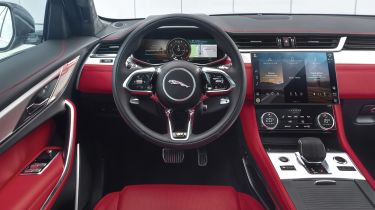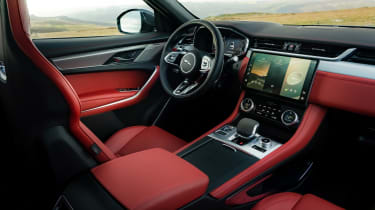Jaguar F-Pace review - Interior, design and technology
The Jaguar F-Pace offers a fresh exterior look, with a revamped cabin and the latest on-board tech

The Jaguar F-Pace remains faithful to the original C-X17 concept first revealed back in 2013 at the Frankfurt Motor Show, and it's arguably one of the best-looking SUVs on the market. Designer Ian Callum did a great job, and the upright, bluff nose and mesh grille, along with the narrow headlights, give the F-Pace a sporty appearance. But despite its vast proportions, its hunkered shape helps to disguise its bulk.
From the front, the F-Pace looks intimidating with its big grille and swept-back headlights, while the Jaguar’s coupe-like profile and narrow window line add an aggressive touch. R-Dynamic versions get sportier-looking bumpers and a trim-specific grille, while Jag offers a range of personalisation options to help you individualise your car.
Subtle visual updates for the 2020 facelift included revised front LED lights that feature the twin J-shaped lighting signature first seen on the I-Pace, along with an enlarged grille. New LED tail-lamps have also been incorporated into the rear design.
The refreshed F-Pace’s gear selector no longer rises out of the centre console, instead there's now a stubby ‘palm-shifter’ that features cricket ball-like stitching. The electric window switches have been moved from the top of the door to the more traditional armrest area, while Jaguar has also injected some added practicality with larger storage holders for bottles.
Sat-nav, stereo and infotainment
Updated F-paces feature JLR’s latest infotainment system called Pivi Pro. It features a gently curved 11.4-inch display that sits slightly proud of the dashboard. It looks great; the graphics are razor-sharp and the colours are bright.
The homepage is split into three sections for navigation, media and phone settings, with a main menu for the other functions to the side. Loading times are incredibly quick; from homepage, to postcode entry to the first instruction of a fully loaded road route takes just 20 seconds which, for comparison, is 12 seconds faster than when we completed the same process in a Volvo XC60.
It’s a shame that there’s no physical shortcut controls anywhere, but the system is generally so good that you rarely miss them. Our only real criticism comes with the screen itself; it’s so shiny that fingerprint smudges show up easily.









